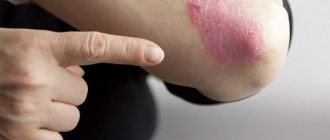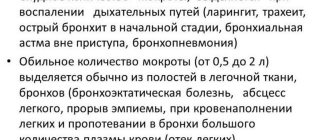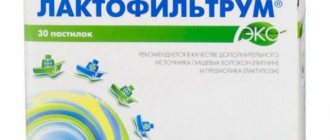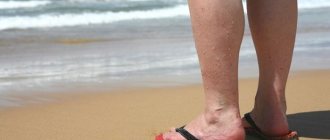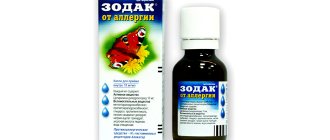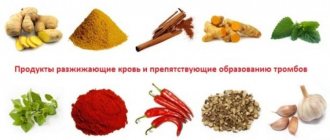Indications for the use of hormonal ointments for allergies
External glucocorticosteroids (GCS) are used to treat many skin diseases. They quickly relieve inflammation, significantly alleviate the course of the disease and effectively eliminate symptoms not only in the acute stage, but also in chronic allergic manifestations on the skin.
They are prescribed for:
- acute inflammation of the skin due to allergies;
- atopic dermatitis;
- photodermatitis;
- neurodermatitis and eczema caused by allergies;
- risk of complications of allergic manifestations;
- if non-hormonal external agents are ineffective.
special instructions
Hormonal ointment for allergies should be prescribed only by a doctor who takes into account the patient’s age, location and nature of the allergic rash.
It is prohibited to use ointments for a long time: more than 12 weeks for adults and more than a month for children.
Patients who need to apply the product to large areas of skin or under occlusive dressings should be periodically examined for suppression of adrenal function.
Side effects of hormonal ointments for allergies
Hormonal ointments for allergies (they are also called “topical steroids”) act locally at the site of application to the skin, without having a general effect on the body. This is their fundamental difference from first-generation drugs, which acted systemically and had many serious side effects.
Topical steroids do not have the disadvantages of systemic drugs, and undesirable consequences arise due to their illiterate use.
What complications may there be:
- self-prescription and uncontrolled use can cause addiction, as a result of which the drugs no longer help;
- with a long course, acne, pigmentation, atrophy and dry skin may appear;
- due to decreased immunity and thinning of the skin at the site of application of the ointment, there is a risk of secondary infection;
- overdose is dangerous because corticosteroids coming from outside reduce the production of their own hormones by the adrenal cortex, as a result glucocorticosteroid insufficiency may develop;
- Sometimes itching, redness and burning of the skin may occur in the area where the ointment is applied.
With proper prescription and use of hormonal drugs, side effects are rare.
Analogs
The following drugs can be called analogues of Prednisolone ophthalmic ointment, but not with an identical composition:
- Stillavit (in the form of eye drops);
- Oftocipro;
- Oftan Timogel;
- Tetracycline ointment (it also contains an antibiotic).
Replacing Prednisolone with an analogue can only be carried out by the attending physician based on the results of a study by an allergist or gynecologist (if pregnancy is confirmed).
In summary, eye ointment with Prednisolone is a powerful anti-inflammatory and anti-allergic agent that inhibits metabolic processes in cells, and at the same time prevents the production of basophils. It works almost 15 minutes after application, the effect lasts about 8 hours. Use only under the direct instructions of a doctor (sold only by prescription).
Types of hormonal ointments for allergies
The number of external glucocorticosteroids registered in Russia includes more than 40 items. They are available in the form of creams, ointments, and lotions. The cream dries out weeping areas of inflammation and is suitable for the treatment of allergic dermatitis in skin folds. The ointment moisturizes well, removes peeling and cracks.
Table of hormonal ointments for allergies by strength
The lotion is intended for the treatment of the scalp. Hormonal ointment for allergies can be single-component (contain one steroid) or combined (with an antibacterial and antifungal substance). Based on their potency, topical steroids are divided into four classes.
Class I - slow penetration, short-term weak effect:
- Hydrocortisone;
- Prednisolone.
Class II - moderate impact:
- Lorinden;
- Fluorocort;
- Triacort;
- Afloderm.
Class III - speed, high degree of activity:
- Advantan;
- Akriderm;
- Cutivate;
- Lokoid;
- Flucinar;
- Sinaflan;
- Synoderm;
- Celestoderm;
- Elokom;
- Uniderm;
- Momat.
Class IV - penetrate deeply into skin cells, providing a powerful anti-inflammatory effect:
- Dermovate.
Class III corticosteroids with a high degree of activity are most often used.
The more powerful the effect of the ointment, the more caution it should be used, strictly following the attached instructions and the recommendations of the attending physician.
Composition and pharmacological properties
White viscous ointment Prednisolone is hemogenic in nature. The main active ingredient is prednisolone , its content in the medicine does not exceed 0.5% of the total mass. Additional components:
- distilled water;
- stearic acid;
- glycerol;
- methylparaben;
- emulsifier;
- propylparaben.
The drug is available in an aluminum tube weighing 10 g. The cardboard package contains one tube of Prednisolone ointment. The recipe in Latin and Russian is included in the package. The main component of the drug is not absorbed into the blood through the skin; it penetrates only into the upper layers of the dermis and has an anti-inflammatory effect on it. In pharmacies, the ointment is sold only with a doctor's prescription.
Prednisolone works by inhibiting bacterial activity. The drug reduces cell permeability, reduces the release of plasma into the intercellular tissue substance. The ointment relieves swelling, slows down the flow of blood to the site of inflammation, reduces the sensitivity of nerve cells, and also removes pain, itching and other signs of discomfort.
Instructions for the use of hormonal ointments for allergies
Hormonal ointment for allergies is a potent remedy, so self-medication with it is unacceptable. The selection of the drug, dosage, frequency of use and duration of treatment are determined by an allergist.
Before first use, you need to conduct a preliminary test on the back of your wrist to check the sensitivity of the skin. The preparations should be used on cleansed skin. Apply especially carefully and only according to indications to the face, neck, skin folds, and eyelids. Do not allow product to come into contact with eyes.
If after two weeks of using the ointment the skin condition has not improved, you should consult your doctor to clarify the diagnosis.
Reviews
Ivan. Often a rash appears on the hands due to poor quality food or alcohol. I use Prednisolone, and everything goes away in just a week.
Elena. Everyone in our family suffers from psoriasis. I constantly felt complex because of this, even in the summer I had to wear long-sleeve sweaters. I went to the doctor and prescribed this ointment. I use it periodically, redness and rashes decrease.
Andrey. In hot weather, I sweat a lot, the glands become clogged and inflammation occurs. The use of Prednisolone ointment was prescribed. I have no regrets - the drug is cheap and effective.
© 2021 – 2021, Evgeniy Nikolaevich Konoplev. All rights reserved.
List of effective hormonal antiallergic ointments: review, prices
The rest of the article discusses the most effective hormonal antiallergic external agents.
Advantan (methylprednisolone aceponate)
It moisturizes the skin well and restores its normal oiliness, eliminates dryness, itching, pain and irritation. For chronic inflammatory processes accompanied by significant thickening and infiltration of the skin, as well as for very dry skin, it is prescribed in the form of a greasy ointment with a high fat content.
Recommended frequency of application is 1 time per day on small areas of the skin. For children it is used from 4 months.
Price range: 494-553 rub. per package 15g, 1123-1193 rub. per pack 50g.
Sinaflan (fluocinolone acetonide)
The drug is preferable for the treatment of dry forms of dermatoses in acute and severe uninfected inflammations of the skin. Apply only to small areas of the body 2-4 times a day in short courses (for children no more than 5 days). To enhance the effect, it can be used under an occlusive dressing.
Price range: 14-60 rub. per pack of 10g, 50-66 rubles. per package 15g.
Comfoderm (methylprednisolone aceponate)
A domestic drug with anti-inflammatory and keratolytic action with the same active ingredient and indications as the imported analogue Advantan.
When used under occlusive dressings, Comfoderm gives good results even with significant changes, thickening, increased pattern and infiltration of the skin. Treatment in several courses is possible.
Price range: 191-235 rub. for a package of 15g, 408-440 rubles. per package 30 g.
Prednisolone ointment (prednisolone)
The product is used in complex therapy for the treatment of allergic dermatitis. Apply 1-3 times a day for a short course from 6 days to 2 weeks. You can apply more often to thick skin on the feet, elbows and palms.
For chronic diseases, after the symptoms disappear, the ointment must be applied for several more days. This will help avoid relapses. The ointment is approved for use in children over 1 year of age.
Not used during pregnancy. It should not be used for a long time; there is a risk of developing systemic side effects and secondary infection. It is recommended to combine with antibacterial and antifungal agents.
Price range: 14-30 rub. per package 10g, 15-32 rubles. per package 15 g.
Afloderm (alclomethasone)
The drug in the form of an ointment and cream is used from 6 months in children and adults for various forms of dermatoses, including those located in the groin area, chest, face and neck.
The ointment is best used for dry skin with signs of peeling. The cream dries wet areas, is easily absorbed, and does not leave an oily sheen, so it is used for the face and scalp.
The course of treatment is short (for children 3 weeks), the frequency of application is 2-3 times per day, followed by follow-up treatment (for children once a day).
Price range: 464 - 526 rub. per pack of 40g ointment, 465 - 526 rubles. per package 40 g of cream.
Gistan-N cream (mometasone)
The drug is indicated for inflammation and itching of the skin due to allergic dermatoses. Not prescribed for children under 2 years of age. Its use on large areas of skin is not recommended. When applied once a day, the therapeutic effect is observed after 3 weeks.
Discontinuation of the drug after long-term therapy should be carried out gradually.
In pharmacies there is a Russian analogue of this drug with the same active ingredient - Mometasone cream 30g at a price of 292-323 rubles.
Elokom (mometasone)
It relieves itching and eliminates inflammation on the skin. Available in the form of cream, ointment and lotion. Frequency of application: 1 time per day. Approved for use in children over 2 years of age. Elokom of any release form is not used under occlusive dressings and is not applied to skin areas under a diaper. Only lotion can be applied to the face, head, armpits and groin areas.
Price range:
- 69-80 rub. per ointment (15 g);
- 67-69 rub. cream (15 g);
- 180-205 rub. per lotion (30 ml).
Beloderm (betamethasone)
The product is available in the form of cream and ointment. For moist, weeping skin lesions, it is better to use a cream, and for flaky skin, an ointment is preferable. Frequency of use: 2 times a day. The duration of treatment for patients with allergic manifestations on the face and children over the age of 1 year is no more than 5 days.
Price range: 175-196 rub. for ointment and cream 30g, 119-127 rubles. for ointment and cream 15 g.
Flucinar ointment and gel (fluocinolone acetonide)
The medicine is used for severe allergic inflammation of the skin and mucous membranes. Apply to the skin, lightly rubbing, no more than 2 times a day. The duration of treatment is usually 2 weeks, in children and when used on the face no more than 1 week. Children under 2 years of age are recommended to use only once a day on small areas of the body.
Price range: 235-280 rub. per pack of 15 g.
Triderm
This is a combination drug (betamethasone + gentamicin + clotrimazole) that has anti-inflammatory, antibacterial and antifungal effects. Cream and ointment are prescribed for dermatoses complicated by infections.
The antibiotic gentamicin has a broad spectrum of action and fights bacteria, and clotrimazole actively destroys the cell membrane of fungi. Triderm must be regularly applied in the morning and before bed not only to the affected skin, but also to the surrounding surface of the skin. With a long course of treatment, gradual withdrawal of the drug is necessary. Not prescribed for children under 2 years of age.
Price range: 607-675 rub. per package 15g.
Elidel cream (pimecrolimus)
This is not a hormonal drug, it does not belong to the group of topical steroids, but its effectiveness is not inferior to them. It very quickly relieves itching and skin inflammation in allergic contact and atopic dermatitis in adults and children from 3 months.
It can be applied to the head, face, neck, diaper rash. Apply 2 times a day until the symptoms of inflammation disappear. At the first signs of relapse, treatment should be resumed immediately to avoid exacerbation. The selective action of pimecrolimus does not lead to skin atrophy and systemic side effects, so long-term use is possible.
Price range: 757-907 rub. for a package of 15 g, 1420-1466 rubles. per package 30 g.
Directions for use and doses
Externally. The ointment is applied in a thin layer to the affected areas of the skin 1 - 3 times a day. The duration of treatment depends on the nature of the disease and the effectiveness of therapy, usually ranging from 6 to 14 days. During the follow-up period, it is possible to use the drug once a day.
On areas with thicker skin (for example, elbows, palms, feet), as well as places from which the drug is easily washed off, the ointment can be applied more often.
On limited lesions, occlusive dressings can be used to enhance the effect.
Drugs for the treatment of allergies in children
The first and most common signs of allergies in children are itching and skin rashes.
The reason may be:
- contact with skin of various tissues;
- household detergents;
- medicines;
- overheat;
- sweating;
- food.
If a child experiences discomfort and painful itching, parents need to follow the following sequence of actions:
- Contact your pediatrician for a correct diagnosis.
- Identify and eliminate the causes that led to the allergic reaction.
- Try to improve the child's condition with ointments that do not contain hormones.
- If they are ineffective, with the help of a doctor, select a suitable external dosage form of a hormone-containing drug in accordance with the age of the child.
Below is a table with the most used ointments for allergies in children of different ages:
| Non-hormonal external agents | Child's age | Hormonal external agents | Child's age |
| Elidel | from 3 months | Advantan | from 4 months |
| Bepanten | from birth | Comfoderm | from 4 months |
| Desitin | from birth | Afloderm | from 6 months |
| Protopik | from 2 years | Beloderm | from 1 year |
| Fenistil | from 1 month | Elokom | over 2 years old |
| Skin cap | over 1 year | Prednisolone | from 1 year |
| Mometasone | from 2 years | ||
| Triderm | from 2 years | ||
| Gistan-N | from 2 years | ||
| Momat | over 2 years old | ||
| Akriderm | from 1 year |
Topical steroids approved for pediatric use are certified safe for children.
However, parents should follow the rules for their use:
- strictly adhere to the instructions included with the medicine and the pediatrician’s recommendations;
- do not independently increase the duration of the course, frequency of application, dosage and area of the treated surface of the child’s body;
- do not use the ointment on the skin under the diaper and under bandages, if this is indicated in the instructions (the risk of side effects due to increased absorption of the drug);
- Cancellation should be carried out gradually (the regimen is recommended by the doctor).
Compliance with these rules will minimize possible risks when using glucocorticosteroid drugs in children:
- suppression of adrenal cortex function and the development of Cushing's syndrome;
- the occurrence of adrenal insufficiency when treatment is discontinued;
- atrophic changes in the skin;
- growth slowdown;
- developmental delay;
- intracranial hypertension.
Side effect
When using the drug, especially in patients with individual intolerance, hyperemia, swelling, itching within the area where the drug is applied, steroid acne, telangiectasia, irritation, and dry skin may occur. With long-term use of the drug, it is also possible to develop secondary infectious skin lesions, atrophic changes in it, and hypertrichosis. To prevent infectious skin lesions, the drug is recommended to be prescribed in combination with antibacterial and antifungal agents.
With long-term use of the drug, especially in large areas of the lesion, the development of hypercortisolism is possible, as a manifestation of the resorptive effect of prednisolone. In these cases, the drug is discontinued.
If any adverse reaction occurs, consult your doctor as soon as possible. If any of the side effects indicated in the instructions get worse or you notice any other side effects not listed in the instructions, tell your doctor.
Overdose
Symptoms: inhibition of the function of the hypothalamic-pituitary-adrenal system, hyperglycemia, glycosuria, Itsenko-Cushing syndrome. Symptoms disappear after stopping use of the drug.
Treatment: gradual withdrawal of the drug, symptomatic treatment, and, if necessary, correction of electrolyte balance.
Preparations that are suitable for use during pregnancy and lactation
The latest generation of external hormonal agents are poorly absorbed through the skin into the blood and have little effect on the functioning of the hormonal system. However, expectant mothers should carefully weigh the pros and cons of their use, especially in the first trimester of pregnancy, when all organs and systems of the fetus are formed.
As a rule, GCS is not prescribed during this period, since glucocorticoids penetrate the placenta, and when treating large surfaces of the skin, their negative effect on the fetus increases.
In the second and third trimesters, the use of topical steroids is possible in exceptional cases, taking into account the balance of harm and benefit for mother and child. They should be used with extreme caution during lactation, since many drugs are excreted into breast milk and can suppress growth and cause undesirable effects in the newborn.
Pregnant and breastfeeding women should remember:
- if allergic reactions occur on the skin, you should consult a specialist: gynecologist, dermatologist, allergist;
- mild manifestations of allergies: mild itching, dry skin, minor rashes and discomfort are relieved by non-hormonal dermatotropic agents (Bepanten, D-panthenol, Radevit, Emolium, Videstim, Skin-cap, Desitin, Zinc ointment);
- the use of external steroids (Afloderm, Elokom, Advantan) is possible in case of urgent need and under the supervision of a physician;
- hormonal agents are not used on large areas of the skin and for a long time;
- before feeding, do not apply ointment to the mammary glands;
- in some cases it is advisable to stop breastfeeding.
Pharmacokinetics
When applied externally, prednisolone is absorbed and the active substance enters the bloodstream. In plasma
90% of prednisolone is in bound form (with transcortin and albumin). Biotransformed by oxidation mainly in the liver; oxidized forms are glucuronidated or sulfated.
It is excreted by the kidneys and bile in the form of metabolites, partially unchanged.
Penetrates the placental barrier and is found in small quantities in breast milk.
Allergy medications for eyelids
Most allergy ointments containing glucocorticosteroids are not intended for application to the eyelids and are not used in ophthalmology. When applied to the skin around the eyes, glaucoma may develop.
For allergic inflammation of the eyelids, eye ointments are prescribed. Hydrocortisone (hydrocortisone) eye ointment relieves inflammation, itching, swelling and redness. Dex-gentamicin (dexamethasone in combination with gentamicin) is used for allergic manifestations accompanied by bacterial infection.
When treating eyelid allergies with corticosteroid eye ointments, it is important to know:
- they are not used in children under two years of age, pregnant women and women during lactation;
- for diabetes mellitus, prescribe with caution;
- ointments are not used for more than one week (long-term use thins the skin and can lead to increased intraocular pressure, glaucoma or cataracts).
Description of the drug
Prednisolone is a thick, white ointment without any specific odor. It is well absorbed by the skin, and the ingredients quickly penetrate into pathological areas. The product has a healing effect a few minutes after its application.
The hormonal drug is used to treat acute and chronic skin diseases. It eliminates almost all clinical manifestations of pathologies of allergic origin.
What does Prednisolone ointment help with:
- swelling and redness of the epidermis, caused by an inflammatory process;
- burning, pain, itching;
- large and small rashes;
- abundant exfoliation of the upper epidermal layer.
The drug is included in therapeutic regimens only by the treating specialist. He studies the patient's medical history and the results of biochemical tests. The dermatologist must take into account the degree of tissue damage and the stage of the pathological process.
Clinical and pharmacological group
Prednisolone cream is included in the clinical and pharmacological group of glucocorticosteroids for external use.
pharmachologic effect
Therapeutic effectiveness is based on the pharmacological properties of the drug component - prednisolone. This is a synthetic analogue of the hormone produced by the adrenal glands, but with a more powerful therapeutic effect.
The active ingredient has the following properties:
- anti-inflammatory. Prednisolone inhibits enzymes that stimulate the production of mediators prostaglandins, leukotrienes, bradykinins;
- antiexudative. The glucocorticosteroid prevents the accumulation of macrophages and leukocytes in inflammatory foci. It is the high concentration of these immune system cells that leads to the formation of edema;
- analgesic. Suppression of prostaglandin production causes a decrease in the severity of pain.
Under the influence of the synthetic hormone, capillary permeability decreases, which is increased by the released histamine. The activity of fibroblasts, secreting precursors of collagen and elastin proteins, decreases.
In addition to Prednisolone ointment, the therapeutic line includes eye drops used in ophthalmic practice. They are prescribed to patients with episcleritis, blepharitis, and blepharoconjunctivitis. Drops are used in the treatment of one of the most common eye pathologies - allergic conjunctivitis.
Release form and composition
Prednisolone ointment is produced by many domestic pharmaceutical factories.
It is available in 10 and 15 g packaging in sealed aluminum tubes. Secondary packaging is a cardboard box with instructions for use included. The ointment base is formed from the following additional ingredients:
- white paraffin;
- methylparaben;
- stearic acid;
- emulsifier;
- propylparaben;
- glycerin;
- purified water.
Auxiliary ingredients ensure maximum absorption of the glucocorticosteroid into inflammatory lesions. And due to paraffin, a protective film is formed on the surface of the skin. It prevents infection of affected tissues against the background of decreased local immunity.
Patients often ask doctors whether the ointment is hormonal or not. The active component prednisolone is a hormone obtained synthetically. Its presence in the composition determines not only the anti-inflammatory effectiveness of the ointment, but also a wide range of contraindications. Therefore, it is necessary to consult with your doctor about the safety of using Prednisolone.
Storage conditions and periods
The drug is stored in a dark place at a temperature of 5-15°C. Shelf life: 24 months. If the temperature regime is violated, the ointment delaminates, changing its color and smell. This indicates the unsuitability of Prednisolone for treatment. After opening the tube, you must use its contents within a month. Young children's access to the drug should be limited.
Facial allergy medications
To eliminate redness, itching, rashes and peeling on the sensitive delicate skin of the face and neck, dosage forms in the form of cream (Advantan, Lokoid, Afloderm) are suitable, and for the scalp - lotion (Elocom). They are quickly absorbed and do not leave an oily sheen.
Glucocorticosteroids for the face are prescribed for severe manifestations of allergies and the absence of effect from the use of non-hormonal ointments. Treatment involves a short course with a frequency of application once a day.
Today, hormonal ointments are the most effective remedy against allergic skin manifestations. In some cases, this is the only way to get rid of serious skin problems. When using them, it is important to remember that the safety of use depends on the correct choice of the drug and compliance with the recommendations for its use.
Article design: Mila Friedan
pharmachologic effect
Prednisolone has anti-inflammatory, antiallergic, antipruritic and antiexudative effects.
Reduces the formation, release and activity of inflammatory mediators (histamine, kinin, lysosomal enzymes). Suppresses cell migration to the site of inflammation; reduces vasodilation and increased vascular permeability at the site of inflammation.
Reduces exudation due to vasoconstrictor action.
Suppresses the action of macrophages, target cells, cytokines that are involved in the development of the reaction in the form of allergic contact dermatitis. Prevents access of sensitized T lymphocytes and macrophages to target cells.


